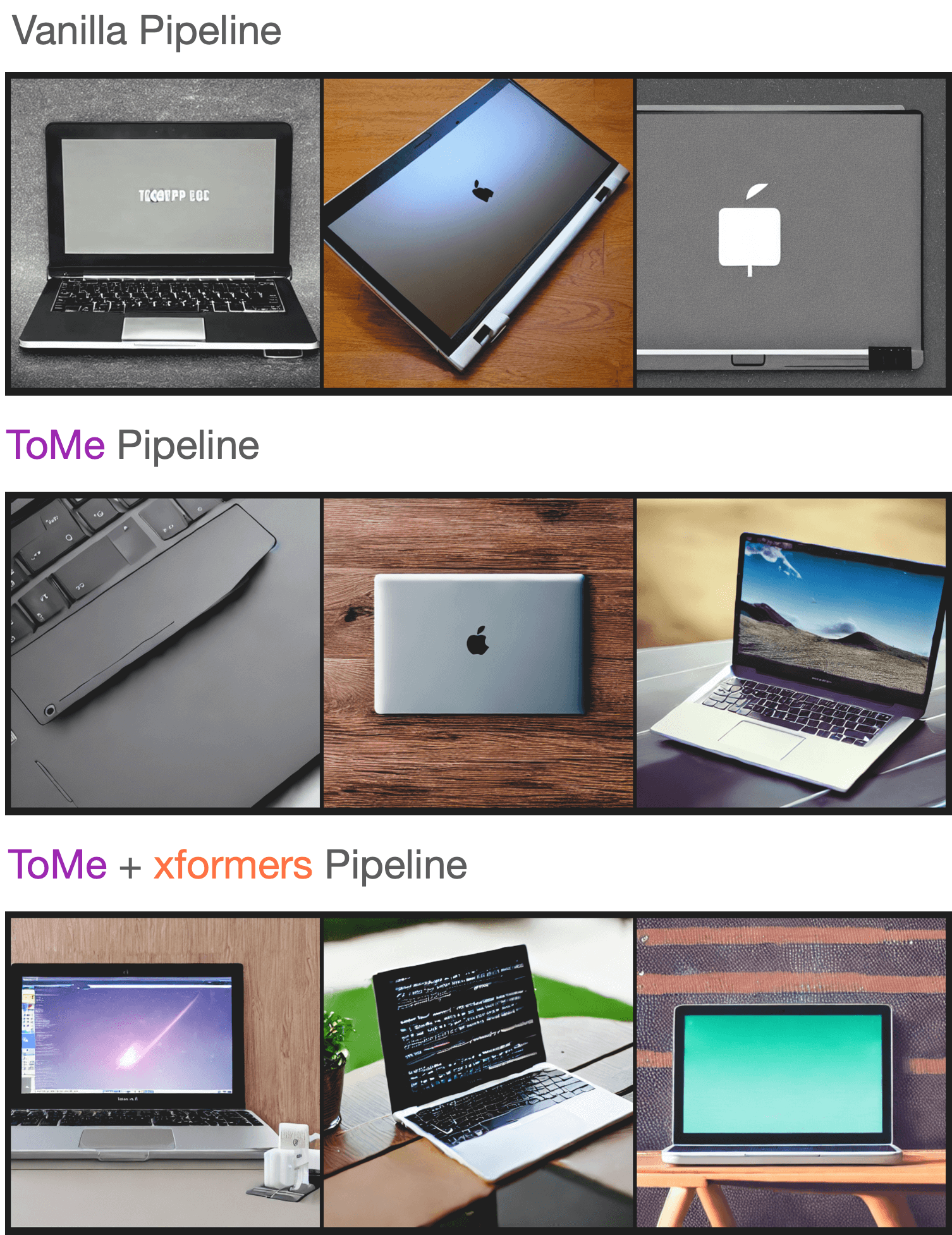Token Merging
Token Merging (introduced in Token Merging: Your ViT But Faster) works by merging the redundant tokens / patches progressively in the forward pass of a Transformer-based network. It can speed up the inference latency of the underlying network.
After Token Merging (ToMe) was released, the authors released Token Merging for Fast Stable Diffusion, which introduced a version of ToMe which is more compatible with Stable Diffusion. We can use ToMe to gracefully speed up the inference latency of a [DiffusionPipeline]. This doc discusses how to apply ToMe to the [StableDiffusionPipeline], the expected speedups, and the qualitative aspects of using ToMe on the [StableDiffusionPipeline].
Using ToMe
The authors of ToMe released a convenient Python library called tomesd that lets us apply ToMe to a [DiffusionPipeline] like so:
from diffusers import StableDiffusionPipeline
import tomesd
pipeline = StableDiffusionPipeline.from_pretrained(
"runwayml/stable-diffusion-v1-5", torch_dtype=torch.float16
).to("cuda")
+ tomesd.apply_patch(pipeline, ratio=0.5)
image = pipeline("a photo of an astronaut riding a horse on mars").images[0]
And that’s it!
tomesd.apply_patch() exposes a number of arguments to let us strike a balance between the pipeline inference speed and the quality of the generated tokens. Amongst those arguments, the most important one is ratio. ratio controls the number of tokens that will be merged during the forward pass. For more details on tomesd, please refer to the original repository https://github.com/dbolya/tomesd and the paper.
Benchmarking tomesd with StableDiffusionPipeline
We benchmarked the impact of using tomesd on [StableDiffusionPipeline] along with xformers across different image resolutions. We used A100 and V100 as our test GPU devices with the following development environment (with Python 3.8.5):
- `diffusers` version: 0.15.1
- Python version: 3.8.16
- PyTorch version (GPU?): 1.13.1+cu116 (True)
- Huggingface_hub version: 0.13.2
- Transformers version: 4.27.2
- Accelerate version: 0.18.0
- xFormers version: 0.0.16
- tomesd version: 0.1.2
We used this script for benchmarking: https://gist.github.com/sayakpaul/27aec6bca7eb7b0e0aa4112205850335. Following are our findings:
A100
| Resolution | Batch size | Vanilla | ToMe | ToMe + xFormers | ToMe speedup (%) | ToMe + xFormers speedup (%) |
|---|---|---|---|---|---|---|
| 512 | 10 | 6.88 | 5.26 | 4.69 | 23.54651163 | 31.83139535 |
| 768 | 10 | OOM | 14.71 | 11 | ||
| 8 | OOM | 11.56 | 8.84 | |||
| 4 | OOM | 5.98 | 4.66 | |||
| 2 | 4.99 | 3.24 | 3.1 | 35.07014028 | 37.8757515 | |
| 1 | 3.29 | 2.24 | 2.03 | 31.91489362 | 38.29787234 | |
| 1024 | 10 | OOM | OOM | OOM | ||
| 8 | OOM | OOM | OOM | |||
| 4 | OOM | 12.51 | 9.09 | |||
| 2 | OOM | 6.52 | 4.96 | |||
| 1 | 6.4 | 3.61 | 2.81 | 43.59375 | 56.09375 |
The timings reported here are in seconds. Speedups are calculated over the Vanilla timings.
V100
| Resolution | Batch size | Vanilla | ToMe | ToMe + xFormers | ToMe speedup (%) | ToMe + xFormers speedup (%) |
|---|---|---|---|---|---|---|
| 512 | 10 | OOM | 10.03 | 9.29 | ||
| 8 | OOM | 8.05 | 7.47 | |||
| 4 | 5.7 | 4.3 | 3.98 | 24.56140351 | 30.1754386 | |
| 2 | 3.14 | 2.43 | 2.27 | 22.61146497 | 27.70700637 | |
| 1 | 1.88 | 1.57 | 1.57 | 16.4893617 | 16.4893617 | |
| 768 | 10 | OOM | OOM | 23.67 | ||
| 8 | OOM | OOM | 18.81 | |||
| 4 | OOM | 11.81 | 9.7 | |||
| 2 | OOM | 6.27 | 5.2 | |||
| 1 | 5.43 | 3.38 | 2.82 | 37.75322284 | 48.06629834 | |
| 1024 | 10 | OOM | OOM | OOM | ||
| 8 | OOM | OOM | OOM | |||
| 4 | OOM | OOM | 19.35 | |||
| 2 | OOM | 13 | 10.78 | |||
| 1 | OOM | 6.66 | 5.54 |
As seen in the tables above, the speedup with tomesd becomes more pronounced for larger image resolutions. It is also interesting to note that with tomesd, it becomes possible to run the pipeline on a higher resolution, like 1024x1024.
It might be possible to speed up inference even further with torch.compile().
Quality
As reported in the paper, ToMe can preserve the quality of the generated images to a great extent while speeding up inference. By increasing the ratio, it is possible to further speed up inference, but that might come at the cost of a deterioration in the image quality.
To test the quality of the generated samples using our setup, we sampled a few prompts from the “Parti Prompts” (introduced in Parti) and performed inference with the [StableDiffusionPipeline] in the following settings:
- Vanilla [
StableDiffusionPipeline] - [
StableDiffusionPipeline] + ToMe - [
StableDiffusionPipeline] + ToMe + xformers
We didn’t notice any significant decrease in the quality of the generated samples. Here are samples:
You can check out the generated samples here. We used this script for conducting this experiment.
